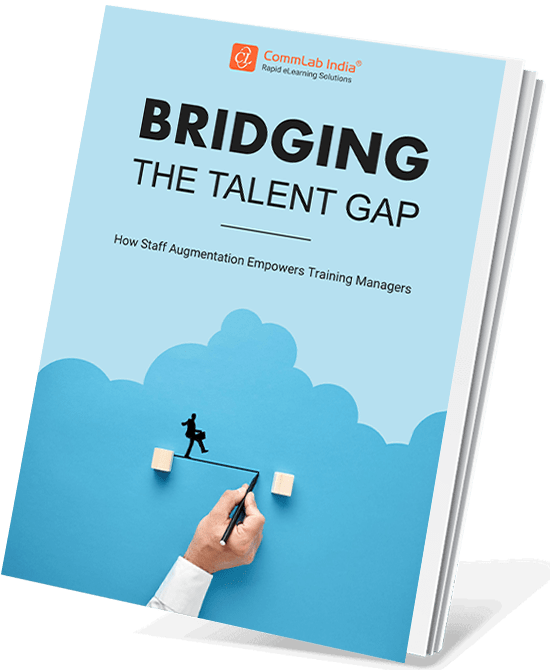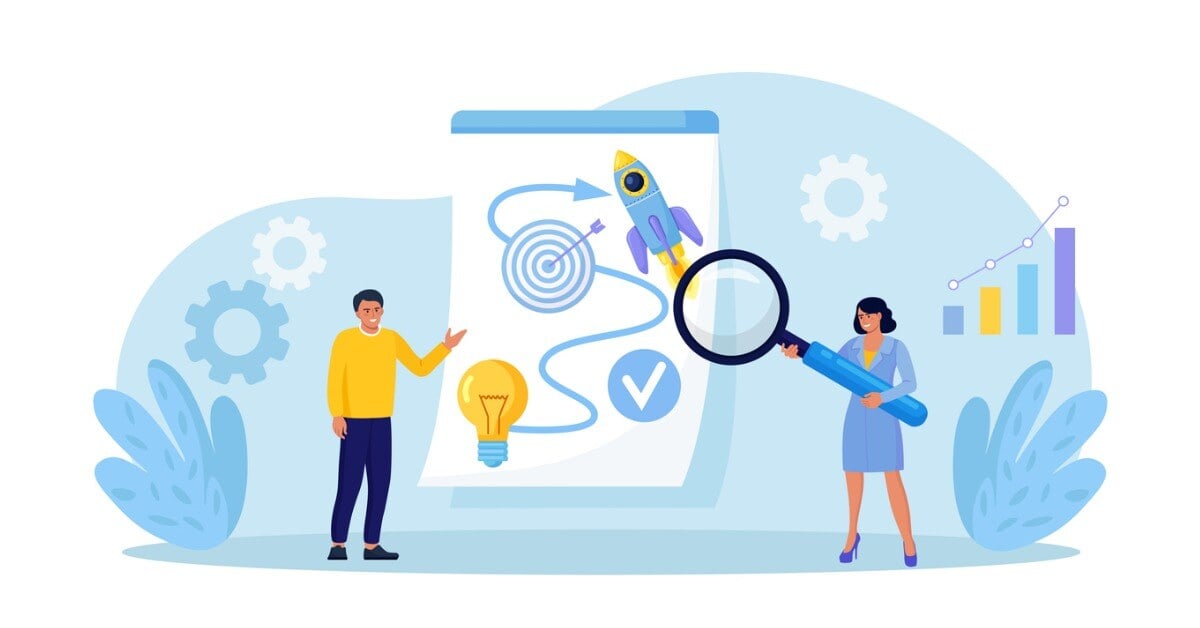Why are High-Performing L&D Teams Saying Yes to Staff Augmentation?

As the world of Learning and Development (L&D) evolves, so do the demands placed on teams responsible for delivering top-notch training programs. For many high-performing L&D teams, staff augmentation has become the secret ingredient to keeping up with the ever-growing complexity of their work. But what exactly is staff augmentation, and why are L&D teams jumping on board? Let’s explore this trend and understand why staff augmentation is becoming a must-have strategy for the best in the business.
→ Download Now: How Staff Augmentation Empowers Training Managers
Table of Contents
- What Are the Challenges Faced by High-Performing L&D Teams?
- What Are the Options Available to Overcome These Challenges?
- What Is the Difference Between Staff Augmentation and eLearning Outsourcing?
- Why Are High-Performing L&D Teams Saying Yes to Staff Augmentation?
- How to Implement Staff Augmentation in Your Organization?
What Are the Challenges Faced by High-Performing L&D Teams?
L&D teams that consistently deliver high-quality training programs are often balancing multiple plates. As their roles expand, so do the challenges they face. Let’s break down some of the common hurdles encountered by high-performing L&D teams.

Resource Constraints
No matter how skilled or dedicated your team is, there are only so many hours in a day. High-performing L&D teams often struggle with limited bandwidth, especially when there are multiple projects running simultaneously.
Skill Gaps
As the learning landscape continues to evolve, so does the need for new skills. Whether it’s expertise in the latest eLearning technologies or specialized knowledge in adult learning principles, skill gaps can become a bottleneck for L&D teams trying to stay ahead of the curve.
Rapidly Changing Learning Landscape
With technology advancing at a frantic pace, keeping up with trends like Artificial Intelligence (AI), immersive learning, or microlearning can be overwhelming. L&D teams need to be agile. However, without the right resources, adapting quickly can be a challenge.
Scalability Issues
As organizations grow, so do their training needs. Scaling L&D programs to meet the demands of a larger or more diverse workforce requires a thorough understanding of instructional design as well as eLearning authoring tools. This area is something that many internal teams struggle to achieve on their own.

Bridging the Talent Gap: How Staff Augmentation Empowers Training Managers
Craft a Dream Team of Exceptional Experts, Meticulously Suited to your Requirements!
- Advantages and Considerations of Staff Augmentation
- L&D Roles that Benefit from Staff Augmentation
- Staff Augmentation Process
- Success Stories
What Are the Options Available to Overcome These Challenges?
To overcome the challenges faced by high-performing L&D teams, particularly around resource constraints, skill gaps, and scalability, organizations have two main options: staff augmentation and outsourcing. Both offer distinct advantages, and the best choice depends on the specific needs and structure of your team.
What Is the Difference Between Staff Augmentation and eLearning Outsourcing?
While both staff augmentation and eLearning outsourcing involve leveraging external resources to meet Learning and Development (L&D) goals, they are two completely different models. Staff augmentation is about temporarily expanding your team’s capabilities while retaining control and management of the project, whereas eLearning outsourcing involves handing over a project to an external provider who manages most aspects of the development process. Both approaches can be valuable for L&D teams, but the choice depends on the level of control, scope, and flexibility you need for your project.
Wondering what all these terms are? Let’s explore each factor in detail and understand how the difference between the two in a thorough manner.
1. Control and Management
In staff augmentation, external talent is integrated into your internal team. You retain full control over the project, workflow, and day-to-day management of the augmented staff. These professionals work alongside your internal team, and your organization maintains responsibility for project oversight, deadlines, and decision-making.
On the other hand, in eLearning outsourcing, you hand over an entire project (or part of a project) to an external vendor. The vendor manages the entire eLearning development process, including timelines, deliverables, and quality control. You provide guidance, but the external team has greater autonomy in handling the project, which reduces the need for direct oversight from your in-house team.
2. Scope of Work
Staff augmentation involves bringing in specific skills or expertise to complement your existing team. For example, you can augment your team with an instructional designer, eLearning developer, Subject Matter Expert (SME), graphic designer, etc., to fill a short-term need or skill gap. These augmented staff members focus on specific tasks within a larger project your internal team is managing.
Talking about the scope of work in eLearning outsourcing, the eLearning outsourcing vendor is responsible for delivering the entire eLearning solution. From instructional design and content development to platform integration and quality assurance, your eLearning outsourcing partner will take care of everything. Clearly, eLearning outsourcing is a more hands-off approach where the external provider handles most of the work from start to finish. Your team is only involved in providing input and reviewing progress.

Bridging the Talent Gap: How Staff Augmentation Empowers Training Managers
Craft a Dream Team of Exceptional Experts, Meticulously Suited to your Requirements!
- Advantages and Considerations of Staff Augmentation
- L&D Roles that Benefit from Staff Augmentation
- Staff Augmentation Process
- Success Stories
3. Flexibility
Staff augmentation is highly flexible. It allows you to scale your team up or down as needed. So if you have a short-term project or need specific skills temporarily, you can bring in external experts for as long as necessary. It’s ideal for projects where you need more control and can’t afford to fully outsource the work.
eLearning outsourcing tends to be less flexible, as it involves contracting a third-party vendor to handle the entire project and its processes. While you can discuss and adjust the project scope with the vendor, it’s often more difficult to make changes mid-project compared to managing an in-house team with augmented staff. With that said, remember that outsourcing is better suited for larger, end-to-end projects where your organization prefers to offload most of the work.
4. Cost Structure
The cost structure in staff augmentation is mostly contractual. This can be in terms of hourly rates, project-based, or based on the number of professionals brought into the team. When it comes to staff augmentation, you have more control over costs because you decide the number of resources needed and the project timeline.
However, in eLearning outsourcing, costs are often associated with the projects. The eLearning vendor provides a quote based on different factors such as the complexity of the project, resources required, deliverables, and the timeline. While outsourcing may have higher upfront costs, it can come in handy for organizations that are looking for comprehensive solutions and budget is not a problem. It includes end-to-end services that require less involvement from the internal team.
5. Long-Term Versus Short-Term Needs
Staff augmentation is a preferred choice for short-term needs, such as filling skill gaps, addressing immediate project demands, or temporarily increasing team capacity during peak times. As mentioned earlier too, it’s a good option when you want to maintain control over the project but are missing specific skills or bandwidth in-house.
Outsourcing is more suitable for longer-term projects or when you want to offload entire processes to an expert team. For example, if your organization is looking to create a comprehensive eLearning program or launch an LMS from scratch, outsourcing the project to a specialized vendor might be a better option.
Wondering how can you find the right vendor for eLearning outsourcing? Your search ends here. Watch this video to know the tips that will help you to make an informed decision.
Now that you’ve got a clear idea of how staff augmentation is different from eLearning outsourcing, it’s time to understand why L&D teams are saying YES to staff augmentation.
Why are High-Performing L&D Teams Saying Yes to Staff Augmentation?
Wondering Why High-Performing L&D Teams Are Saying Yes to Staff Augmentation?
Here’s a list of reasons you shouldn’t miss:
- Access to Specialized Expertise
- Scalability and Flexibility
- Cost-Effectiveness
- Reduced Time-to-Market for Learning Initiatives
- Better Work Experience
We all know that high-performing Learning and Development (L&D) teams are always looking for ways to meet increasing demands, adapt to fast-changing learning landscapes, and deliver high-quality training initiatives. For such situations, staff augmentation has emerged as a valuable solution. Let's explore how staff augmentation helps these teams overcome challenges and deliver impactful results together!
1. Access to Specialized Expertise
In today’s complex training environment, L&D teams often require skills that go beyond their in-house expertise. Whether it’s developing a course on a highly technical subject or implementing a new learning management system (LMS), certain tasks demand niche knowledge that may not be readily available on your team. This is where staff augmentation proves beneficial. It provides access to specialized skills and allows high-performing L&D teams to bring in experts with the specific skill sets they need.
For instance, if your L&D team is tasked with creating a course on advanced data analytics or engineering concepts, finding an in-house expert can be a challenge. And if you decide to hire a new member, it can be time-consuming and can mess with your budget. However, by augmenting your team with specialists, you can ensure that the content is accurate, engaging, and designed by those with the right knowledge without burning a hole in your pocket.
Similarly, if and when your organization decides to implement a new LMS or adopt cutting-edge rapid eLearning authoring tools, having someone with prior experience can drastically improve the success and speed of the rollout. With staff augmentation, you can quickly tap into the expertise you need without going through lengthy hiring processes or training someone internally.
In short, staff augmentation allows high-performing L&D teams to seamlessly integrate the right talent for specific projects, ensuring they always have access to the skills needed to achieve excellence. Thus, the reason why they say “Yes” to staff augmentation.
2. Scalability and Flexibility
One of the biggest challenges for L&D teams is managing fluctuating workloads. Sometimes, your team might be working on multiple high-priority projects simultaneously, and other times, there could be a long pause. Handling this variability while keeping your team motivated and productive can be difficult. To tackle such situations in a better way, high-performing L&D teams say yes to staff augmentation.
It allows flexible resource allocation. That’s right! With staff augmentation, L&D teams have the flexibility to scale up or down based on project demands. For instance, when a large project is on the horizon, you can bring in additional instructional designers, developers, or project managers to meet the deadline. Once the project is complete, you can easily scale back without the long-term commitment of hiring full-time staff.
Moreover, staff augmentation offers a respite by preventing employee burnout. We all know and understand that overburdening your internal team with too many tasks can lead to burnout, decreased productivity, and lower morale. However, high-performing L&D teams skip this phase by augmenting their team with external talent. You can do it too! Make sure that you distribute the workload more evenly and give your core team the breathing room they need to stay focused on their primary responsibilities and maintain high performance over time.
3. Cost-Effectiveness
I’m sure you’d agree that hiring full-time employees comes with significant costs. This is especially painful when specialized skills are needed for short-term projects. Recruitment, onboarding, training, and other benefits to full-time employees can strain budgets.

On the other hand, staff augmentation allows L&D teams to bring in talent only when it’s needed and save costs. For instance, if you require a localization expert for a global training initiative or a graphic designer to create visual assets for a course, staff augmentation enables you to access these skills on a temporary basis without the overhead costs of hiring permanent employees. This allows you to allocate your budget more efficiently while still delivering high-quality learning solutions.
4. Reduced Time-to-Market for Learning Initiatives
In the fast-paced corporate world, the ability to launch training programs quickly can be a competitive advantage. However, hiring and training new employees can be a time-consuming process that delays the rollout of important initiatives. This is where high-performing, successful L&D teams take advantage of staff augmentation.
Staff augmentation ensures faster project completion and accelerates the time-to-market by bringing in professionals who can hit the ground running. So for example, when your organization needs to quickly develop a new course or launch a learning initiative, augmented staff with the right experience can contribute immediately, bypassing the lengthy process of recruiting, onboarding, and training new hires.
With staff augmentation, faster time-to-market doesn’t mean compromised quality. You read it right! Augmented staff assists in-house L&D teams to meet tight deadlines without compromising quality. It’s just that more people with relevant skills enhance productivity and reduce the development time of the learning program. This speed is especially important in fast-changing industries where timely training can significantly impact performance and outcomes.
5. Better Work Experience
One of the hidden benefits of staff augmentation is its positive impact on your internal team. High-performing L&D teams often face the challenge of juggling multiple responsibilities—from strategy and stakeholder management to the actual execution of learning programs. This workload can quickly become overwhelming.
However, by leveraging staff augmentation impactful L&D teams can focus on strategic priorities. The core L&D team can delegate execution tasks (e.g., content development, LMS administration, etc.) to external experts while freeing up their time to focus on more strategic responsibilities. The core responsibilities can vary from aligning learning initiatives with business goals to building relationships with stakeholders.
High-performing L&D teams also say yes to staff augmentation to ensure a balanced workload and higher morale. As staff augmentation helps reduce the pressure on internal staff, it creates a more balanced workload, leading to better morale and overall job satisfaction. When employees can focus on what they do best without being overloaded, they’re more likely to be engaged and productive.

Bridging the Talent Gap: How Staff Augmentation Empowers Training Managers
Craft a Dream Team of Exceptional Experts, Meticulously Suited to your Requirements!
- Advantages and Considerations of Staff Augmentation
- L&D Roles that Benefit from Staff Augmentation
- Staff Augmentation Process
- Success Stories
How to Implement Staff Augmentation in Your Organization?
Implementing staff augmentation in your organization can provide the flexibility, expertise, and scalability you need to tackle complex Learning and Development (L&D) challenges. To ensure a smooth and successful implementation, it’s essential to follow a structured approach. Here’s a step-by-step guide to help you get started:
1. Identify Your Needs and Objectives
Before bringing in external talent, clearly define the specific skills or roles you need to fill. Ask yourself these questions:
- What gaps exist in your current L&D team?
- Are there specialized skills you need for upcoming projects (e.g., instructional design, LMS administration, eLearning development)?
- Do you need additional hands for a temporary workload surge or ongoing support?
Having a clear understanding of your needs will help you determine the exact resources and expertise you require.Make sure to map out the roles and responsibilities for the project. This will help ensure that augmented staff are well-aligned with your team’s goals and project outcomes.
2. Choose the Right Staff Augmentation Model
There are different models of staff augmentation. Depending on the nature of your organization’s project needs, determine which model fits best.

3. Select a Staff Augmentation Partner
Finding the right partner is critical to the success of your staff augmentation efforts. When selecting a vendor or external provider, there are several key factors to consider. First, look for providers with a strong reputation and proven experience in L&D staff augmentation, as well as solid references.
Whether you're looking for instructional designers, LMS administrators, or eLearning developers, it's important to ensure that the vendor's talent pool matches your specific needs. Apart from the alignment of skillset with required needs, it’s also important to check that the external workforce is a good fit with your corporate culture and values. This will allow for smooth integration and effective collaboration with your internal team. To verify all these factors and select a suitable staff augmentation partner, request case studies or examples of how the provider has successfully augmented L&D teams for similar projects.
4. Define Clear Roles and Responsibilities
Once you’ve selected a provider, clearly outline the roles and responsibilities of the augmented staff. This should include scope of work, reporting structure, key deliverables, project timeline, etc. To do so, establish a detailed project plan and communicate this with both your internal team and augmented staff to minimize confusion.

5. Create a Strong Onboarding Process
It's so important to make sure that the augmented staff members feel welcome and included when they join a company. A great way to do this is to make sure that there is a smooth onboarding process in place for them. To ensure everything goes as smoothly as possible, start by helping the augmented staff members understand your company's values, culture, and workflows. This will help them to fit in and work well with your existing team.
It's also a great idea to show your new team members the ropes when it comes to the tools and processes your team uses, such as your LMS, project management software, and communication platforms. Moreover, assigning a mentor from your internal team to the augmented staff can further facilitate smoother integration by offering guidance and answering questions. A thorough onboarding process ensures that augmented staff can hit the ground running and feel like part of the team from the start.
6. Establish Clear Communication Channels
Make sure that your augmented staff are on the same page as your team when it comes to your goals. Having open and clear communication channels is the best way to do this! Regular check-ins should be scheduled to discuss progress, address any issues, and ensure alignment with project objectives. Setting up a system for providing constructive feedback is also important.
Furthermore, augmented staff should be encouraged to share their own insights. For this, you can leverage various collaboration tools. Collaboration tools also help keep communication streamlined and transparent. Fostering open communication between your internal team and the augmented staff will create an efficient working environment.

7. Track Performance and Measure Success
Lastly, evaluate the effectiveness of staff augmentation by establishing and analyzing the key performance indicators (KPIs) and metrics for success. This can include project completion rates, quality of work, cost-effectiveness, etc. You can also try gathering feedback from both your internal team and the augmented staff to assess how well the integration is working and identify any areas for improvement.
In The End!
It’s clear why high-performing L&D teams are saying “yes” to staff augmentation. They can use external talent to overcome resource constraints, fill skill gaps, and scale their efforts to thrive in today's fast-paced business environment. So what are you waiting for? Say yes to staff augmentation to join the high-performing L&D teams club. Got the appetite to learn more about staff augmentation? Then here’s an eBook you can’t miss. Download now!





